Artículo
A solar flare driven by thermal conduction observed in mid-infrared
López, Fernando Marcelo ; Giménez De Castro, Carlos Guillermo; Mandrini, Cristina Hemilse
; Giménez De Castro, Carlos Guillermo; Mandrini, Cristina Hemilse ; Simões, Paulo J. A.; Cristiani, Germán Diego
; Simões, Paulo J. A.; Cristiani, Germán Diego ; Gary, Dale E.; Francile, Carlos Natale; Démoulin, Pascal
; Gary, Dale E.; Francile, Carlos Natale; Démoulin, Pascal
 ; Giménez De Castro, Carlos Guillermo; Mandrini, Cristina Hemilse
; Giménez De Castro, Carlos Guillermo; Mandrini, Cristina Hemilse ; Simões, Paulo J. A.; Cristiani, Germán Diego
; Simões, Paulo J. A.; Cristiani, Germán Diego ; Gary, Dale E.; Francile, Carlos Natale; Démoulin, Pascal
; Gary, Dale E.; Francile, Carlos Natale; Démoulin, Pascal
Fecha de publicación:
01/2022
Editorial:
EDP Sciences
Revista:
Astronomy and Astrophysics
ISSN:
0004-6361
Idioma:
Inglés
Tipo de recurso:
Artículo publicado
Clasificación temática:
Resumen
Context. The mid-infrared (mid-IR) range has been mostly unexplored for the investigation of solar flares. It is only recently that new mid-IR flare observations have begun opening a new window into the response and evolution of the solar chromosphere. These new observations have been mostly performed by the AR30T and BR30T telescopes that are operating in Argentina and Brazil, respectively. Aims. We present the analysis of SOL2019-05-15T19:24, a GOES class C2.0 solar flare observed at 30 THz (10 μm) by the ground-based telescope AR30T. Our aim is to characterize the evolution of the flaring atmosphere and the energy transport mechanism in the context of mid-IR emission. Methods. We performed a multi-wavelength analysis of the event by complementing the mid-IR data with diverse ground- and space-based data from the Solar Dynamics Observatory (SDO), the H-α Solar Telescope for Argentina, and the Expanded Owens Valley Solar Array (EOVSA). Our study includes the analysis of the magnetic field evolution of the flaring region and of the development of the flare. Results. The mid-IR images from AR30T show two bright and compact flare sources that are spatially associated with the flare kernels observed in ultraviolet (UV) by SDO. We confirm that the temporal association between mid-IR and UV fluxes previously reported for strong flares is also observed for this small flare. The EOVSA microwave data revealed flare spectra consistent with thermal free-free emission, which lead us to dismiss the existence of a significant number of non-thermal electrons. We thus consider thermal conduction as the primary mechanism responsible for energy transport. Our estimates for the thermal conduction energy and total radiated energy fall within the same order of magnitude, reinforcing our conclusions.
Palabras clave:
SUN: ACTIVITY
,
SUN: CHROMOSPHERE
,
SUN: FLARES
,
SUN: INFRARED
Archivos asociados
Licencia
Identificadores
Colecciones
Articulos(IAFE)
Articulos de INST.DE ASTRONOMIA Y FISICA DEL ESPACIO(I)
Articulos de INST.DE ASTRONOMIA Y FISICA DEL ESPACIO(I)
Citación
López, Fernando Marcelo; Giménez De Castro, Carlos Guillermo; Mandrini, Cristina Hemilse; Simões, Paulo J. A.; Cristiani, Germán Diego; et al.; A solar flare driven by thermal conduction observed in mid-infrared; EDP Sciences; Astronomy and Astrophysics; 657; 1-2022; 1-10
Compartir
Altmétricas



